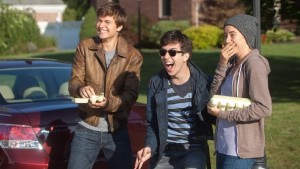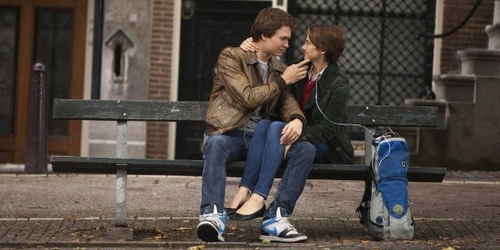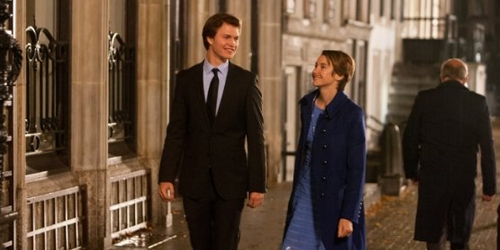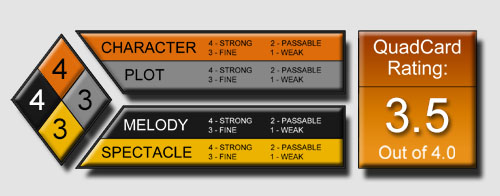 Whether on not you’re a fan of John Green’s work, young adult novels, or just appreciate a good story, The Fault in Our Stars is probably the most unexpectedly delightful film you’ll see this season. Based on Green’s immensely popular novel of the same name it’s an account of three kids dealing with cancer and hard life issues at a young age. It’s about kids with the disease but it’s not about the disease. They, despite their condition, are just as normal as you can expect and still full of life and hope in light of their disease. But the story doesn’t paint a happy-go-lucky picture, just an honest one.
Whether on not you’re a fan of John Green’s work, young adult novels, or just appreciate a good story, The Fault in Our Stars is probably the most unexpectedly delightful film you’ll see this season. Based on Green’s immensely popular novel of the same name it’s an account of three kids dealing with cancer and hard life issues at a young age. It’s about kids with the disease but it’s not about the disease. They, despite their condition, are just as normal as you can expect and still full of life and hope in light of their disease. But the story doesn’t paint a happy-go-lucky picture, just an honest one.
Stripped of most elements likely found populating a YA film these days, The Fault In Our Stars doesn’t feel fabricated, forced or false; it’s an efficient production that doesn’t fall back on trappings of tween-based films. No montages, no rebelliously mood  swings or shifts in tone, there’s not even a John Hughes era themed soundtrack. Josh Boone takes Green’s book and crafts a seemingly effortless adaptation that puts story first and stays that way for the duration. The film has a grounded and very real quality to it even if its magnetic leads come across more than slightly self-aware. That said it doesn’t come across like say Juno where the young kids’ wit and delivery seem suspiciously scripted and far beyond their years, however some similarities do exist.
swings or shifts in tone, there’s not even a John Hughes era themed soundtrack. Josh Boone takes Green’s book and crafts a seemingly effortless adaptation that puts story first and stays that way for the duration. The film has a grounded and very real quality to it even if its magnetic leads come across more than slightly self-aware. That said it doesn’t come across like say Juno where the young kids’ wit and delivery seem suspiciously scripted and far beyond their years, however some similarities do exist.
So, short on gimmicks and long on emotional impact, the film fleshes out Green’s novel with reverence and casts such amazing young actors (check out our insightful interview with Woodley, Wolff and Green here) that this entire picture feels like a warm blanket. Everything about it resonates – the cast, the characters, the narrative, etc. Now writing a story and dialogue is one thing, and John Green is known for amazingly accessible and stories that move you, but The Fault In Our Stars is flawless filmmaking simply because the source material is so dense with realism it seems like a documentary (one with a decent production budget).
It’s a story about kids with cancer but Green’s novel (whom he devoted to a woman he knew named Esther Earl) makes it clear that the disease does not identify the individual; it does in fact strengthen them and their resolve. But, to those wary of a Lifetime styled film, worry not. This holds back just short of being hokey or depressing…and at times this is quite hilarious. There are some heavy emotional through lines that takes the audience along the characters’ journey and we feel the devastation of the disease. Not physically but more so mentally and emotionally and it all has to do with the cast who make Gus, Hazel and Isaac more than just figures on the screen. They become stunningly real and we see past Gus’ prosthetic leg, Hazel’s oxygen tank and Issac’s glass eye. They are confident and the spark within them is so hypnotic because they have such a compelling screen presence.
Cast to perfection the film follows the trio and it makes you like them right from the very start. Green’s writing is more than half of the reason this adaptation is a rousing success but Shailene Woodley, Ansel Elgort and Nat Wolff bring it the rest of the way. But they’re also supported by the people in their lives affected by the cancer, most notably Hazel’s parents. As you might expect this doesn’t throw a pity party for the characters. In addition to the cancer they’re still going through things kids normally face – love, loss, acceptance, hyper-sensitive parents, etc. and the story principally focuses on that aspect.

There’s a dynamic to supporting characters like Hazel’s parents (Laura Dern and Sam Trammell) that bring gravity and depth to Hazel as a character. Because of her condition, which hit her at a young age, their lives have become focused her and they have been hovering so much so that they have lost their identity. Hazel is afraid that that when she is gone they will have nothing because their whole life has been refocused to be about her. It’s not too heavy handed but it’s easy to understand where they are coming from. Elgort and Woodley dial in to the heart of the novel and effortlessly and wonderfully portray Gus and Hazel.

Paired opposite Woodley is Ansel Elgort and he is the ying to Hazel’s yang. They find solace in each other’s opposites and are happy to have found someone with whom they can truly relate – an equal with whom they can share the room. He is everything that Hazel isn’t and that goes a long way in making them immensely interesting. Of course it helps that Elgort plays well off Woodley as he truly has an incredible amount of potential with a star-making quality about him. The two open each others eyes and the unlikely relationship is the crux of the story but when things don’t fare well for them, you’ll be glad you brought the kleenex.
G-S-T RULING:
The Fault In Our Stars is a young adult novel but there’s such an accessible quality to Green’s story and characters that this really caters to all walks of life. Those who know the novel (like the slew of teens in the press screening) will take to seeing characters they adore lovingly brought to life on screen and those new to the story will have no trouble understanding the appeal. Simply put, The Fault In Our Stars is endearing and captivating. Moreover it’s the magnetic appeal of stars which makes the film’s unique and heart-swelling love story fun, exciting, and pretty much every other praiseworthy adjective you deem fit to describe this wonderful movie.



